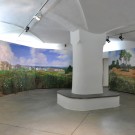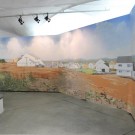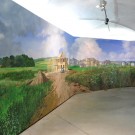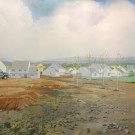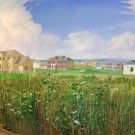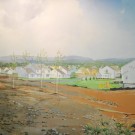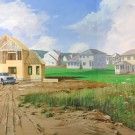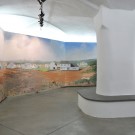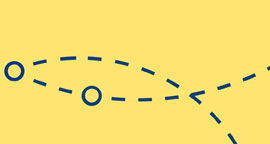Centre for Contemporary Culture at Palazzo Strozzi
Palazzo Strozzi
Adam Cvijanovic
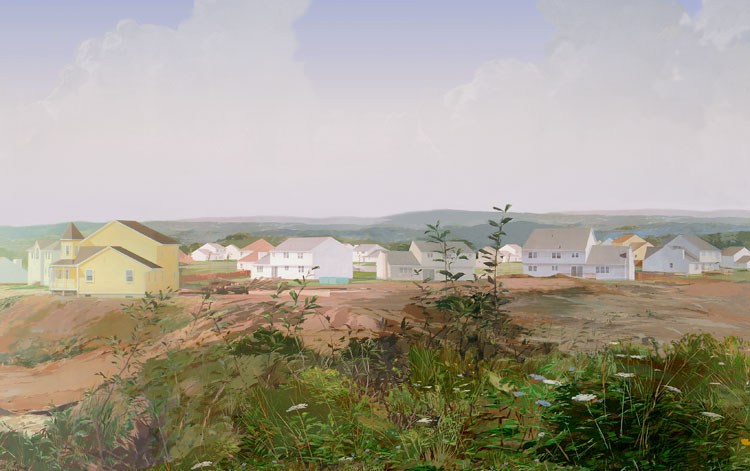
Adam Cvijanovic’s painting draws visitors into a visual illusion, a surprising panorama that portrays a typically American urban landscape that can be interpreted in two different ways: is it being demolished or built?
Warning: A non-numeric value encountered in /var/www/vhosts/strozzina.org/httpdocs/admin/wp-content/plugins/lightbox-gallery/lightbox-gallery.php on line 443
- Exhibition view "American Dreamers", CCC Strozzina, Palazzo Strozzi, Firenze
Adam Cvijanovic New City, 2001-2012 Pittura acrilica su materiale sintetico / Acrylic paint on synthetic material. Courtesy l’artista e / the artist and Blindarte Contemporanea, Napoli (foto Martino Margheri)
- Exhibition view "American Dreamers", CCC Strozzina, Palazzo Strozzi, Firenze
Adam Cvijanovic New City, 2001-2012 Pittura acrilica su materiale sintetico / Acrylic paint on synthetic material. Courtesy l’artista e / the artist and Blindarte Contemporanea, Napoli (foto Martino Margheri)
- Exhibition view "American Dreamers", CCC Strozzina, Palazzo Strozzi, Firenze
Adam Cvijanovic New City, 2001-2012 Pittura acrilica su materiale sintetico / Acrylic paint on synthetic material. Courtesy l’artista e / the artist and Blindarte Contemporanea, Napoli (foto Martino Margheri)
- Exhibition view "American Dreamers", CCC Strozzina, Palazzo Strozzi, Firenze
Adam Cvijanovic New City, (particolare/detail), 2001-2012 Pittura acrilica su materiale sintetico / Acrylic paint on synthetic material. Courtesy l’artista e / the artist and Blindarte Contemporanea, Napoli (foto Martino Margheri)
- Exhibition view "American Dreamers", CCC Strozzina, Palazzo Strozzi, Firenze
Adam Cvijanovic New City, (particolare/detail), 2001-2012 Pittura acrilica su materiale sintetico / Acrylic paint on synthetic material. Courtesy l’artista e / the artist and Blindarte Contemporanea, Napoli (foto Martino Margheri)
- Exhibition view "American Dreamers", CCC Strozzina, Palazzo Strozzi, Firenze
Adam Cvijanovic New City, (particolare/detail), 2001-2012 Pittura acrilica su materiale sintetico / Acrylic paint on synthetic material. Courtesy l’artista e / the artist and Blindarte Contemporanea, Napoli (foto Martino Margheri)
- Exhibition view "American Dreamers", CCC Strozzina, Palazzo Strozzi, Firenze
Adam Cvijanovic New City (particolare/detail), 2001-2012 Pittura acrilica su materiale sintetico / Acrylic paint on synthetic material. Courtesy l’artista e / the artist and Blindarte Contemporanea, Napoli (foto Martino Margheri)
- Exhibition view "American Dreamers", CCC Strozzina, Palazzo Strozzi, Firenze
Adam Cvijanovic New City (particolare/detail), 2001-2012 Pittura acrilica su materiale sintetico / Acrylic paint on synthetic material. Courtesy l’artista e / the artist and Blindarte Contemporanea, Napoli (foto Martino Margheri)
- Exhibition view "American Dreamers", CCC Strozzina, Palazzo Strozzi, Firenze
Adam Cvijanovic New City (particolare/detail), 2001-2012 Pittura acrilica su materiale sintetico / Acrylic paint on synthetic material. Courtesy l’artista e / the artist and Blindarte Contemporanea, Napoli (foto Martino Margheri)
- Exhibition view "American Dreamers", CCC Strozzina, Palazzo Strozzi, Firenze
Adam Cvijanovic New City (partivolare/detail), 2001-2012 Pittura acrilica su materiale sintetico / Acrylic paint on synthetic material. Courtesy l’artista e / the artist and Blindarte Contemporanea, Napoli (foto Martino Margheri)
The large-scale panorama realized for the exhibition by Adam Cvijanovic addresses the subject of the typical single-family American home in relation with the idea of natural and urban landscapes.
The artist started from his personal observation of actual suburban places, the residential fringes of Hillsborough, New Jersey and New City, New York, which are two examples of typical American suburbia and are also traditional symbols of the American dream. In more recent times, these scenes have also become symbols of the current economic crisis that occurred with the explosion of the speculative bubble in the real estate market.
Where human presence is denied, nature appears to become the sole protagonist of the work. A wide and rich vegetation and a reassuring blue sky seem to control the scene. However, the real main character is rooted in the effect that resulted from human intervention. This is made clear not only by the many houses under construction or already built, but also in considering the diverse and incoherent architectural styles. Even the natural elements that the artist portrays are the result of human intervention. We can recognize plants, trees and flowers that are not native to these places, but were brought to this part of America by the first European settlers.
Like in his other works, the artist started with a photographic documentation of real landscapes. Then inside his studio Cvijanovic created what he defines as “portable frescoes”: sections of the paintings are realized on tyvek, a durable, lightweight material easily transportable and mountable. Like in a sort of “analogic photoshop”, all the different painted strips and portions are then applied on the wall of the gallery. After, the artist uses brushes and paints to fix the overlays and empty spaces. The final work becomes a sort of revision of a site-specific intervention in which the artwork reacts to the specific conditions of the context where it is exhibited. For this occasion, Cvijanovic’s work reacts to the peculiar plan of the room and also reflects his knowledge and expertise of traditional Renaissance principles of perspective in terms of techniques and subjects.
Cvijanovic also draws inspiration from the first acknowledged school of American art, the nineteenth-century Hudson River School known for the development of the “American sublime”. This style inspired light-drenched, grandly-scaled landscapes as expressive symbols of the contrast between beauty and strength found in American nature. Cvijanovic paints views of the present Hudson River valley, thus portraying what is now left of these untainted lands that were formerly imbued with the idea of America as God’s promised land.
Adam Cvijanovic (1960, Cambridge, MA, USA; lives and works in New York) studied at the Philadelphia College of Art (1982) and Columbia University (1986) but he is largely self-taught. His early career was as a mural painter and now his work is considered as one of the most interesting among the figurative painters in the New York art scene. Known for his “portable murales”, Cvijanovic is often attracted to images of ruins used as symbol for the decadency of contemporary American culture. His solo shows have been held at many international museum and galleries like Bellwether Gallery, New York; The Massachusetts MoCA, North Adams, MA; The Armand Hammer Museum of Art and Cultural Centre of Arts, Los Angeles, CA. His paintings have also been featured in exhibitions at PS1 Contemporary Art Center in New York, the Royal Academy in London, the New Orleans Biennial, the Walker Arts Center and the Liverpool Biennial at the Tate Liverpool. Recent collective exhibitions include: (2010) Undefined Borders for Unlimited Perceptions, Blindarte Contemporary, Naples; The Sixth Borough, Governors Island, New York; Defrosted: A Life of Walt Disney, Postmasters Gallery, New York; Nothing Gold Can Stay, Robert Goff Gallery, New York; (2011) Alpine Desire, Australian Cultural Forum, New York; COLORIFIC! We Make An Art Rainbow, Postmasters Gallery, New York.
